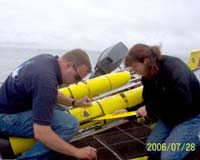| . |  |
. |
Washington (AFP) May 26, 2009 Just 200 years ago, tens of thousands of whales swam the waters around New Zealand while sharks patrolled the British coastlines, say researchers who tell of lost abundance in the world's oceans. Around 100 global experts have united under a group called the Census of Marine Life to study the state of the Earth's waters from a historical viewpoint and how advances in technology have wielded devastation on sealife. The decade-long project brings researchers to Vancouver, Canada from Tuesday and aims to publish its final report in 2010 with inputs from historical accounts as well as geological, botanical and archeological research. "What we are looking at is a global picture of decline because of fisheries and habitat destruction," said Poul Holm, professor at Trinity college Dublin and one of the authors of a report to be presented at the three-day conference. The revolution in fishing first came in the 1600s, when boaters began taking their vessels out in pairs to fish with nets. Then, large scale fisheries began to take hold in the 1800s. "The impact of early fisheries was substantial," Holm told AFP. "The impact on ocean life has been enormous. And it happened earlier than anyone would have thought." Not so long ago, marine fauna was more abundant, fish were bigger and predators more numerous. But the size of fish began to decline in Europe from the Middle Ages with the first mass-scale fisheries, and the variety of underwater sealife began to shrink as well. Today, even the predator population is but 10 to 15 percent of what it was at the start of the 19th century, researchers say. One hundred years ago, cod measuring 1.5 meters (nearly five feet) was frequently sold while today the biggest are around 50 centimeters (20 inches) because of overfishing and the trend of catching the cod too early. The cod's average lifespan has also dropped dramatically from 10 years to barely 2.8, according to Holm. Researchers point to losses in the whale population particularly around New Zealand, whose waters boasted between 22,000 and 32,000 whales at the start of the 1800s but only had about 25 in 1925. Around a thousand live today off the country's southern coast. In the same area, where historians say settlers began moving to in the 13th century, the snapper population was seven times higher then. In most of the zones studied, changes brought on by human activity stretched on for a periods of more than a thousand years but radical changes are also observable within the space of just a few dozen years. In south Florida's Key West for example, the average size of a fish in the mid 1950s was 20 kilograms (50 pounds). Today it is 2.3 kilograms (five pounds). Still Holm says the findings give reason for hope. "It's very useful to just be aware of what we have lost," said Holm. "Although we are detecting a story of decline, its actually a hopeful message," he added. "Because we can use the evidence to suggest that if we step back, if we introduce conservation measures, fisheries regulations and avoid some of the stresses that cause harm to ocean life, we will be able to rebuild ocean life to a level which provides a lot of hope and would be able to feed many more people than the oceans are able today." Share This Article With Planet Earth
Related Links Water News - Science, Technology and Politics
 Baltimore Students Demonstrate First Seaperch Underwater Robotics
Baltimore Students Demonstrate First Seaperch Underwater RoboticsBaltimore, MD (SPX) May 26, 2009 Engineers from Lockheed Martin's Baltimore facility have joined approximately 40 Baltimore City high school students when they demonstrated, for the first time, the SeaPerch Remotely Operated Vehicles that the employees helped the students build. The event, held at the Baltimore Polytechnic Institute, included teams of students from the Institute and the Maritime Industries Academy and was ... read more |
|
| The content herein, unless otherwise known to be public domain, are Copyright 1995-2009 - SpaceDaily. AFP and UPI Wire Stories are copyright Agence France-Presse and United Press International. ESA Portal Reports are copyright European Space Agency. All NASA sourced material is public domain. Additional copyrights may apply in whole or part to other bona fide parties. Advertising does not imply endorsement,agreement or approval of any opinions, statements or information provided by SpaceDaily on any Web page published or hosted by SpaceDaily. Privacy Statement |